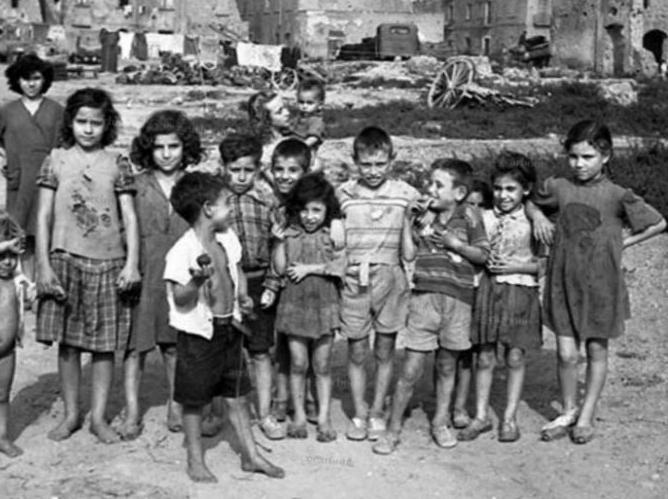
Italian Post-World War II Elections (1946-48)

Figure 1.--The photo was taken in Naples on Sunday October 24, 1948. Naples is the largest city in the south. The consequences of the war are still very evident and the Italian Economic Miracle had not yet began to transform the country. The Communists were hopeful that the Italian electorate would turn to the Communist-Socialist United Front (FDP) in the all important 1948 election. Naples voted Communist, but the rest of the south did not. The strength of the CPI was in the industriakl north. A FDP swwp did not occur. This did not occur. Democrazia Cristiana (Christian Democrats-DCP) won a resounding victory. It is at this time that the Italian Economic Miracle began. Led by developments in Germany, both democracy and capitalism began to transform Italy. Scenes like this quickly disappeared.
|
|
The rapid development of the Italian economy after World War II was a major success story. It probably saved Italy from turning to the Communists and following Eastern Europe into the Soviet Empire. Even after NATO was formed and America made a military commitment to Western Europe, Stalin was still hopeful of cracking the Western alliance. He pinned his hopes on the Cmmunist parties in the West, especially the large French and Italian Communist parties. The Communists had gained considerable prestige during the last 2-years of World War II. They were the only effective Italian resistance to the Germans and Fascists as the Allies drove up the Peninsula. They proved to be the backbone of the the Partisan movement. The first important post-War election resulted in the Communists (ICP) polling nearly 20 percent of the vote (1946). Even though the Italian left (Communists and Socialists) polled about 40 percent of the vote, the Democrazia Cristiana (Christian Democrats - DCP) who polled only 35 percent of the vote formed the government. The Communists were given the Justice Ministry. The Communists exploited public disatisfaction with economic conditions and the May Crisis durng 1947 with strikes and disorders designed to bring down the Government, but failed. The Italiamn left decided to form a United Front (FDP) for the next election. This would be a crucial election because it was before the Economic Miracle had kicked in. And it would be vital to Italy's economic future. Italian industrialists and even small businessmen were not going to make investments in a country run by a Socialist-Communist Government. Democrazia Cristiana (Christian Democrats-DCP) led by Alcide De Gasperi won a resounding victory with 48 percent of the vote, an astonishing victory in multi-party parlimentary system (1948). This would prove to be their best result ever, never repeated. The FDP only received only slightly over 30 percent of the votes, less than the combined Socialist-Communist vote in 1946. The ICP subtanially outpolled the more moderate Socialists within the FDP. The 1948 election would set the mold for subsequent Italian elections. For nearly four decades, Italian elections would be won by the DCP. Italian industrial workers were the backbone of the ICP believing that Communism would lead to higher wages and prosperity. In fact, Communism where adopted was so inefficent, that workers were paid very low wages. This became apparent early on. The Eastern European revolts against the Communists which began in 1953, primarily centered on worker disatisfaction with low wages and poor working conditions. The ICP was led by Palmiro Togliatti who like many other European Communists spent most of the inter-War era in the Soviet Union. There they were carefully vetted by the NKVD. Many disappeared into the Gulag. Togliatti survived. He led the ICP in post-War Italy to become the second largest political party in Italy, and the largest non-ruling communist party in Europe. The success of the Italian Economic Miracle ultimately prevented the PCI from winning national elections during Togliatti's life. The ICP did win many municipal elections and governed quite a number of cities and and regions, most Naples and the industrial north..
CIH

Navigate the Boys' Historical Clothing Italian pages:
[Return to the Main Italian Economic Miracle]
[Return to the Main Itlalian economy page]
[Return to the Main Itlalian page]
[Return to the Main European economy page]
[Return to the Cold War Italy page]
[Italian art]
[Italian catalogs]
[Italian choirs]
[Italian movies]
[Italian royalty]
[Italian school uniforms]
[Italian youth groups]
Navigate the Children in History Website:
[About Us]
[Introduction]
[Biographies]
[Chronology]
[Climatology]
[Clothing]
[Disease and Health]
[Economics]
[Freedom]
[Geography]
[History]
[Human Nature]
[Ideology]
[Law]
[Nationalism]
[Presidents]
[Religion]
[Royalty]
[Science]
[Social Class]
[Bibliographies]
[Contributions]
[FAQs]
[Glossaries]
[Images]
[Links]
[Registration]
[Tools]
[Children in History Home]
Created: 7:38 AM 7/31/2018
Last updated: 7:39 AM 7/31/2018



